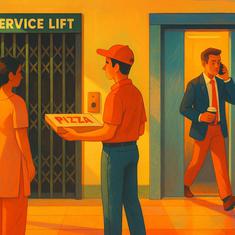There is a short answer and a long answer to the question in the headline. The short answer: it worked out very well for the prime minister and the ruling party. The resounding victory his party won in several state assembly elections in March is proof of that. There’s a new spring in the step of party president Amit Shah, and cabinet ministers now gloat that the position of the prime minister is reserved for Narendra Modi till 2024. In general, voters have bought the line that demonetisation was a courageous assault on the corrupt and the filthy rich on behalf of the poor and the downtrodden.
#cartoon @timesofindia #DeMonetisation #upelections2017 pic.twitter.com/VmC0TgTo0o
— Sandeep Adhwaryu (@CartoonistSan) January 8, 2017
But it is also fair to say that demonetisation has worked out pretty well for the above-mentioned corrupt and filthy rich. What do we mean by that, and how do we know this? What we mean is that those who had black money by the truckload have managed to: (i) put all of that money into the banking system and (ii), get it converted into white – or new legal currency – at a small cost to themselves and little gain to the government.
How do we know this? As for (i), we know this because the government and the Reserve Bank of India continue to maintain radio silence about the extent of demonetised currency that has flown back even four months after the window for depositing old notes closed. Mind you, until December 13, the RBI was giving out updates on how much currency was returning and it stopped doing so only when it looked like the dam was about to burst, with news reports even suggesting that even more money could return to the system than had been printed by the RBI because fake currency too was finding its way to the banks. Since this government is not particularly known for being coy about its wins, the sudden and continued silence begs to be taken as confirmation that the money is all in.
Counting of old notes to still take a few months: Economic Affairs Secretary https://t.co/1Wnx1eCurJ #india #rbi #notes #DeMonetisation pic.twitter.com/YTGqh82DAB
— Firstpost (@firstpost) May 5, 2017
What we do know
But how do we know (ii) that the money has got back into the system without much gain for the government? That is easy. Remember that initially, the government was counting on black money not returning to the banks at all, so that the RBI could then invalidate the unreturned money and find a way to transfer that sum as a bonanza to the government. But once it was clear that most of the money was indeed coming back, the government panicked and brought in a new voluntary disclosure of income scheme that allowed black money holders to declare their ill-gotten money by paying a 50 % tax on it, and keeping another 25% in the Pradhan Mantri Garib Kalyan Yojana at no interest as a fixed deposit for four years. This scheme for voluntary disclosure closed on March 31, 2017.
So if we know how much tax was paid under this scheme, we know exactly how big a price was paid by the fat cats to get their illegal money converted into legal white. Thankfully, we do know the figure. Take a guess what that number could be? Bear in mind that someone like Jagdish Bhagwati, the numero uno economist who had put his weight behind the demonetisation move, had quoted a figure of Rs 5 lakh crore as the extent of currency held in black, in a co-signed article in a business newspaper. Assuming that all of that Rs 5 lakh crore had returned to the system, contrite and now willing to pay a 50 % tax, government’s coffers should have puffed up by Rs 2.5 lakh crore. Compared to that, how much did the government actually collect as penalty and tax? Rs 2 lakh crore? Rs 1 lakh crore? May be Rs 50,000 crore? Nope. The government collected a grand royal sum of about Rs 2,300 crore under the scheme.
PMGKY: Centre collects only Rs 2,300 crore as tax penalty https://t.co/JW7IeV4XJj via @IndianExpress
— Naishadh Vyas (@naishadhvyas) April 6, 2017
In other words, if we go by the Bhagwati figure of Rs 5 lakh crore as the extent of currency held in black, the filthy rich whom the government was assaulting mercilessly have so far paid less than 0.5% of their illegal currency hoard to the government as the cost of converting it all into new currency. If you were one of them, you would think that things worked out pretty well – and maybe you would even decide it is time to open a champagne bottle.
Pinaki Mishra MP BJD says ' IT is most corrupt dept & #DeMonetisation has offered a feast to IT,it's a #Dracula in charge of a blood bank"🔴🔴
— Sanjeev khandekar (@Chemburstudio) January 6, 2017
As for Income Tax Department...
Of course, one could argue that the game is not over yet. That the Income Tax department could go after the suspicious depositors one by one and extract from them what is due to the government. But anyone who knows how the IT department functions would take such arguments with a large pinch of salt. According to the Central Board of Direct Taxes, it has identified 1.8 million people whose deposits do not match their taxpayer profiles. The IT department has a sanctioned staff strength of about 72,000 with a vacancy rate of 30%, and the yearly tally of cases scrutinised comes to barely 3.5 lakh. Even if the entire department drops everything they are currently doing (which will mean less revenue from those cases) and focuses only on these 1.8 million cases, it will take at least five years to scrutinise them all. In other words, there is no easy way the department can dramatically increase the revenue it is currently earning, especially when you take into account the opportunity costs of not doing their regular scrutiny. The fat cats perhaps know this. Or they know other things that we don’t. Either way, since they have decided not to take the voluntary disclosure bait, a reasonable bet would be that they are feeling quite comfortable with the situation. The fact that the Union Budget for 2017 projects no abnormal increase in income-tax collections suggests the comfort they feel is not baseless.
Cartoon #DeMonetisation #BlackMoney #Statistics #Data #ModiWhereIsBlackMoney pic.twitter.com/sKEybGEo7q
— alok nirantar (@caricatured) January 3, 2017
Stated reasons
In his speech announcing the withdrawal of the notes on November 8, Prime Minister Modi put forward four big reasons for the move. Apart from tackling black money, the other three were tackling corruption, fake currency and terror financing. So let us go through them one by one.
As far as corruption is concerned, even economists close to the government who supported the demonetisation move admit that demonetisation in any case could not have been expected to have any effect on the future flow of black money, but only on the already existing stock. In the words of Bhagwati and his co-authors: “it is a truism to argue that it cannot by itself tackle future flows of black money.” Their argument is, of course, correct. And there’s anecdotal evidence, from the IT department itself, that supports it.
As for fake currency, the government is yet to answer what precise security features the new notes have that the previous ones didn’t. If anything, the numerous reports of faulty new currencies being dispensed by ATMs and banks suggest it should be easier to print fake currency now than earlier. Reports like this only strengthen that suggestion.
@goyalsanjeev @narendramodi @crpfindia @rajnathsingh @HMOIndia @mediacrooks I can't stomach this sad news after having believed our beloved PM that #DeMonetisation had neutralized #Maoists @RepubIicofIndia @TimesNow pic.twitter.com/JHUsfzxlSJ
— Naresh Minocha (@nmleo1) April 24, 2017
What about terror financing? At the height of the demonetisation mayhem, one of the claims repeatedly made by the government was that it had broken the back of both the stone-pelters in Kashmir and the Maoists in tribal regions. A flippant claim, one would think, but a claim that many media channels bought into with great excitement. As events in both Kashmir and Chattisgarh have shown since, if at all anything was broken, it was probably toenails, not the backbone. So this claim too doesn’t stand up to scrutiny that well.
That brings us to rationalisations that the government put forward after the demonetisation exercise started – the primary among them being the need to move towards cashless digital payments. Let’s keep aside the question whether moving towards cashless payments is a great idea in the first place and merely check whether this objective is being met at all.
Data (not that anyone cares these days) says that Cash usage is going back to its pre-demonetization level.
— Srivatsa (@srivatsayb) April 15, 2017
Imaginary cashless economy? pic.twitter.com/UzgCKDTl3W
Niti Ayog, which has been at the forefront defending the demonetisation move, put out some astonishing claims about the growth in digital payments after demonetisation, but the figures released by the RBI demolished those claims in a very embarrassing manner. There’s also this statement by the CEO of the National Payments Corporation of India saying the number of digital transactions is declining.
There is thus a fair degree of consensus now that digital payments growth is by and large reverting to the trend that was prevalent before demonetisation, with many who were forced to go digital returning to usual practice. The expectation that digital payments would grow at a new exponential rate has been virtually given up.
Govt data indicates #Demonetisation devoured 1.52 lacs jobs while Modi promised to create 2 crore jobs every year.#Jumla_e_Modi pic.twitter.com/WUxkhkdgot
— Gopi Shah⚇ گوپی شاہ (@gops333) May 2, 2017
The flip side
So much for the gains. But what about losses? Did the significant losses to Gross Domestic Product that were predicted come about? At first look, perhaps not. The Economic Survey put the losses due to demonetisation at 0.25% to 0.5% of GDP, compared to a 2% hit to GDP predicted by former Prime Minister, Manmohan Singh. But this could be because current GDP measurements rely too much on the organised sector and too little on the unorganised.
Such an anti-national cartoon on India's post-demonetisation GDP growth, by Mint's Jayachandran. pic.twitter.com/izwSj59A0D
— Rohin Dharmakumar (@r0h1n) March 3, 2017
It is well accepted that the brunt of demonetisation was borne by the unorganised sector and the organised sector may even have gained a little bit through higher market share. A Quarterly Employment Survey done by the government captures this differential impact in an indirect manner: it says in the third quarter of 2016-17, the manufacturing sector added 72,000 employees, but laid off 1,12,000 casual workers. Economist Prabhat Patnaik gives a variety of other reasons too for why the hit to GDP looks less in official figures than in real life.
Stock market behaviour, again a barometer of organised sector performance, has been noticeably bullish this year, with the Sensex going past 30,000 for the first time. That suggests a relief that the worst fears about demonetisation haven’t materialised at least as far as listed companies are concerned. It is worth bearing in mind, however, that over the last three years, the Sensex has gone up by barely 31% – or by less than 9.5% a year.
Demonetisation hits real estate market in Mumbai and Thane - Times of India https://t.co/lisWpWPakE #RealEstateMarketing pic.twitter.com/FDmRqScv4B
— REMarketing.pro (@remarketing_pro) April 27, 2017
In sum, demonetisation has been a hugely rewarding exercise for the prime minister and the ruling party, an interesting and ultimately relaxing experience for the fat cats with black money, a time of desperation for casual workers and the unorganised sector, a period of consolidation and relief for the organised sector, and an occasion for unrestrained schadenfreude (pleasure derived by someone from another’s misfortune) for many – even if that feeling was based on a non-truth.
You could call this a wash, with nothing much gained in real terms and nothing much lost either. You could also call it a moral disaster – a time when a popularly elected government made a winning political calculation and turned a blind eye to the misery it inflicted upon millions – those who lost their lives without access to cash, those who forfeited their hard-earned life savings because the government broke its promise on how and when to get their notes exchanged, those who were fired from their jobs because there was no money in the system, those who were left holding worthless currency because they didn’t know the system, or were unlucky or were sick...
There also may be a bigger price that we are yet to pay, as a direct result of the lesson the government has learnt from the political success of the exercise: that there is virtually no limit to what it can do, because the people are willing – and perhaps even eager – to sacrifice much.
If eternal vigilance is the price of liberty, it looks like far too many people would rather not buy it.
Tony Joseph is a former Editor of BusinessWorld and can be reached at tjoseph0010@twitter.com










